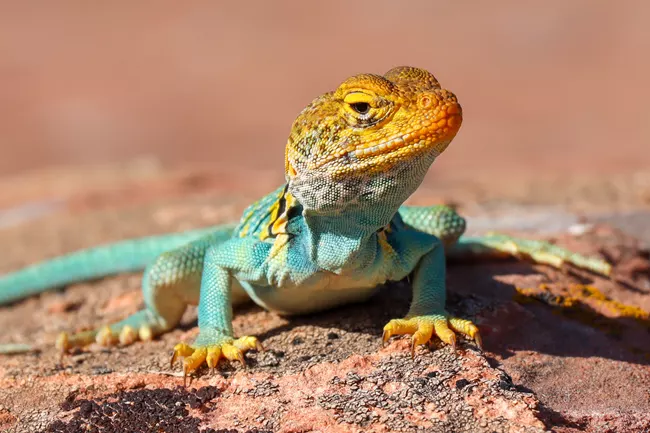
Description:
Scientific name: Crotaphytus collaris
Life span: 5-8 years
The common collared lizard (Crotaphytus collaris), also known as the eastern collared lizard, collared lizard of Oklahoma, collared lizard with a yellow head, and collared lizard, is a member of the Crotaphytidae family of lizards. The colorful common collared lizard has a long tail, a big head, and strong jaws. Because of its distinctive coloring, which includes bands of black over the neck and shoulders that resemble a collar, the term “collared lizard” was coined.
Native Region/Habitat
In North America, common collared lizards can be found. The complete range of its habitat in the United States extends from the Ozark Mountains to Western Arizona. They are found in Mexico and the south-central United States, including Oklahoma, Missouri, Texas, Arizona, Arkansas, Colorado, New Mexico, and Kansas. These lizards favor canyons and rocky locations with minimal vegetation. They live in dry, open habitats with sagebrush, desert scrub, and open forests..

Behavior:
Common collared lizards spend much of their time alone and are active during the day. They are frequently spotted basking on rocks, although they are highly wary and elusive. They are reasonably quick sprinters and can run on their hind legs. Record speeds have been in the neighborhood of 16 mph (26 km/h). Typically active from mid-March to mid-September, common collared lizards hibernate underground in burrows under big rocks during the colder months of the year.
Care As a pet/In captivity:
Enclosure:
The minimum size of the cage for one collared lizard should be 36 inches by 18 inches by 18 inches (around 40 gallons). However since collared lizards are very active animals, give them a bigger enclosure if you can! Cohabitation is not required. It is not necessary to house them with other collared lizards, however it can be done. Male-collared lizards are territorial and will fight if you have more than one of them in the same terrarium because they are. The safest option appears to be small groups of females who are of comparable size. Only if you intend to procreate should a male and female(s) be kept together. You will need an enclosure that is 48″ x 24″ x 24″ or more to house many collared lizards together.
Temperature:
Collared lizards enjoy extreme heat! They should have cold side temperatures of 75–90°F and a basking surface temperature of 105–120°F. The heat source should be turned off to achieve the recommended nighttime temperature range of 68-78°F. Use a digital probe thermometer and set the probe on the suitable surface to take your temps.
Humidity:
According to the species. Whereas collared lizard species in the east are more likely to prefer humidity levels between 50 and 60 percent, collared lizard species in the west perform well in the range of 30 to 40 percent. Using a digital probe hygrometer and placing the probe in the centre of the enclosure, gauge the average humidity levels in your terrarium.
Diet:
Collared lizards are largely insectivorous, which means that in order to provide their bodies with the nutrients they require, they must consume insects (ideally alive). Every morning, give them as much food as they can consume in a single day. In general, children will consume more food than adults. To provide a healthy diet, make careful to provide as many different kinds of bugs as you can. Feeding insects for collared lizards include crickets, hornworms, mealworms, red runner roaches, discoid roaches, and dubia roaches.
Table





